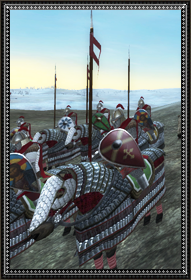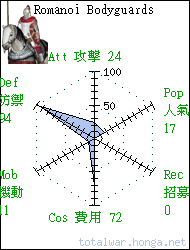|
|
|
Romanoi Bodyguards
|

Views 查看: 584
|
Class and category 兵種 |
heavy cavalry
|
| Soldier 兵員數量 |
bodyguards_ere, 10, 0, 1.1
Soldier model, Number of the soldier, Number of extras, Mass of the men
兵種或其乘員, 數量, 附屬單位數量, 衝擊質量
|
| Mount 騎乘座騎 |
mount half kat, elephant -4, camel -2
Type of animal or vehicle ridden on and its effect
座騎或載具種類及其影響效果
|
| Engine and Ship 攻城器與戰船 |
Siege engine or ship
攻城器具或船隻種類
|
| Attributes 特殊屬性 |
sea_faring, hide_forest, very_hardy, can_withdraw, general_unit
A miscellanious list of attributes and abilities the unit may have
兵種特殊屬性或能力
|
| Formation 陣形 |
2.5, 4, 3, 6, 2, square
|
| Hit points 生命值 |
1, 0
Hit points of man, Hit points of mount or attached animal (Ridden horses and camels do not have separate hit points)
生命值, 附屬單位生命值(座騎無額外的生命值)
|
| Primary weapon 主武器 |
10, 14, no, 0, 0, melee, melee_blade, piercing, spear, 25, 1, no
Attack factor, Charging bonus factor, Missile type, Range of missile, Missile ammunition, Weapon type, Tech type, Damage type, Sound type, Min delay between attacks, Skeleton compensation factor in melee, Weapon attributes
攻擊力, 衝鋒加成, 遠程彈藥種類, 射程距離, 彈藥數, 武器類型, 攻擊方式, 傷害類型, 聲響, 攻擊間隔, 動作補償, 武器特殊屬性
|
| Secondary weapon 副武器 |
4, 8, no, 0, 0, melee, melee_blade, blunt, mace, 25, 1, ap
Attack factor, Charging bonus factor, Missile type, Range of missile, Missile ammunition, Weapon type, Tech type, Damage type, Sound type, Min delay between attacks, Skeleton compensation factor in melee, Weapon attributes
攻擊力, 衝鋒加成, 遠程彈藥種類, 射程距離, 彈藥數, 武器類型, 攻擊方式, 傷害類型, 聲響, 攻擊間隔, 動作補償, 武器特殊屬性
|
| Primary armour 主防禦 |
10, 18, 4, metal
Armour factor, Defensive skill, Shield factor, Sound type
護甲防禦值, 格檔技巧, 盾牌, 聲響
|
| Secondary armour 副防禦 |
0, 0, flesh
Animal's or vehicle's armour factor, Defensive skill, Shield factor, Sound type
附屬單位之護甲防禦值, 格擋技巧, 盾牌, 聲響
|
| Heat and ground effect 氣候地形影響 |
4, -4, -4, -4, -2
Extra fatigue suffered by the unit in hot climates, Scrub, Sand, Forest, Snow
炎熱對疲勞度的影響, 灌木叢地形影響, 沙地, 森林, 雪地
|
| Mental 士氣 |
14, disciplined, highly_trained
Morale, Discipline, Training
士氣, 紀律, 訓練
|
| Cost 招募成本 |
1, 814, 407, 184, 107, 814
Number of turns to build, Cost of unit to construct, Cost of upkeep, Cost of upgrading weapons, Cost of upgrading armour, Cost for custom battles, Limit in custom battle, Cost for punish
徵召回合, 招募費, 維持費, 升級武器, 升級盔甲, 自訂戰役, 多於幾隊, 懲罰金額
|
| Unit Description 兵種描述 |
|
|
 |
 Early E.Roman Bodyguards were the elites. Their names would vary but not their function. They had been called “Athanatoi” or “Excurbitores” before that. Not much more is needed for those horsemen. They were chosen among the best of Kataphraktoi or maybe even foreign mercs to wear besides the “esolorikon” ¾ inch thick padded gambeson, an extra “lorikion” chain mail or scale armor hauberk up to their face, sometimes a “klibanion” lamellar armor cuirass over it and on top of that an “epilorikion” (quilted cloth armor gambeson designed to absorb blunt trauma, like that of a mace). They wear reinforced iron helmets with iron scale aventails and have small iron circular shoulder protectors. They identified themselves by tufts of hair on their armour and tufenk in their helmets.They also wore outmoded pieces of equipment, as the ancient “pteryges” leather strips which protected the genitals. A proud sign of Hellenic and Ancient Roman heritage, and another sign of distinction. A gorget protects the neck made of mail or less likely scale. They carry a reinforced kite shield with the “kontarion” lance on the other hand. They also carry a “spathion” longsword, 36in long (excluding the hilt) and hung at the left hip. Their forearms are protected by “cheiropsella” interlocking lamellar pieces. Lower feet would be protected by “podopsella” interlocking lamellar pieces as well. Their horses are barded in the finest iron lamellar the ironsmiths of the E. Roman empire can muster. Their battle role if needed would be that of lancers, either creating or exploiting a break in the enemy line. This unit’s ultimate role, however, is the protection of the royalty entrusted to its keep, and since Komnenoi are known for their reckless assaults on the enemy that task is very hard. It is absolutely essential that this martial tradition remains however as historically emperor Manuel was selected by his father over his older brother Isaakios, for his prowess in battle. He couldn’t have been half as brave without selected heavy horsemen guarding him. Historically, the heavy horsemen bodyguards were one of the most ancient elite cavalry troops of the Roman Empire. They are heavily armed, not different than the Kataphraktoi or Klibinarioi of earlier line troops, but in some minor details. First Hellenic state to have fielded them more than 1400 years before was the Kingdom of Baktria, followed suit by Seleukeides when Antiochos III nearly lost his life fighting them in Arrius river. Then he used Kataphraktoi horsemen to form his very own bodyguard. Romani fielded heavy numbers of Kataphraktoi to counter Parthian then Sassanid Grivnavpar. Kataphraktoi and their fights with their Sassanid counterparts were the stuff of legend in their time. No emperor would dare fight without his kataphraktoi bodyguards. Despite the power of their devastating charge, and their zeal in protecting their Emperor, the blitzkrieg of Arab light cavalry, and the dire straits of the empire at the time, pushed them into extinction as a fighting unit, with lighter cavalry taking over their role. Ioannis Tzimiskes must have re-established them in the 9th and 10th century amidst the great Roman counterattack on all fronts which pushed the boundaries of Roman domain into present day Armenia and Iraq and reclaiming the Balkans, Cyprus and Crete for the empire. Post Manzikert their numbers were devastated, and nearly brought to end when the “Athanatoi” heavy cavalry (another name for the Early bodyguard ) were killed to a man trying to stop the Normans in the time of the first Komnenos emperor. Still Manuel, was made an Emperor because of his prowess in battle, and some Kataphraktoi horsemen like those of the Early bodyguard who kept him alive. As such, their role remains unchanged in the battlefield.
Early E.Roman Bodyguards were the elites. Their names would vary but not their function. They had been called “Athanatoi” or “Excurbitores” before that. Not much more is needed for those horsemen. They were chosen among the best of Kataphraktoi or maybe even foreign mercs to wear besides the “esolorikon” ¾ inch thick padded gambeson, an extra “lorikion” chain mail or scale armor hauberk up to their face, sometimes a “klibanion” lamellar armor cuirass over it and on top of that an “epilorikion” (quilted cloth armor gambeson designed to absorb blunt trauma, like that of a mace). They wear reinforced iron helmets with iron scale aventails and have small iron circular shoulder protectors. They identified themselves by tufts of hair on their armour and tufenk in their helmets.They also wore outmoded pieces of equipment, as the ancient “pteryges” leather strips which protected the genitals. A proud sign of Hellenic and Ancient Roman heritage, and another sign of distinction. A gorget protects the neck made of mail or less likely scale. They carry a reinforced kite shield with the “kontarion” lance on the other hand. They also carry a “spathion” longsword, 36in long (excluding the hilt) and hung at the left hip. Their forearms are protected by “cheiropsella” interlocking lamellar pieces. Lower feet would be protected by “podopsella” interlocking lamellar pieces as well. Their horses are barded in the finest iron lamellar the ironsmiths of the E. Roman empire can muster. Their battle role if needed would be that of lancers, either creating or exploiting a break in the enemy line. This unit’s ultimate role, however, is the protection of the royalty entrusted to its keep, and since Komnenoi are known for their reckless assaults on the enemy that task is very hard. It is absolutely essential that this martial tradition remains however as historically emperor Manuel was selected by his father over his older brother Isaakios, for his prowess in battle. He couldn’t have been half as brave without selected heavy horsemen guarding him. Historically, the heavy horsemen bodyguards were one of the most ancient elite cavalry troops of the Roman Empire. They are heavily armed, not different than the Kataphraktoi or Klibinarioi of earlier line troops, but in some minor details. First Hellenic state to have fielded them more than 1400 years before was the Kingdom of Baktria, followed suit by Seleukeides when Antiochos III nearly lost his life fighting them in Arrius river. Then he used Kataphraktoi horsemen to form his very own bodyguard. Romani fielded heavy numbers of Kataphraktoi to counter Parthian then Sassanid Grivnavpar. Kataphraktoi and their fights with their Sassanid counterparts were the stuff of legend in their time. No emperor would dare fight without his kataphraktoi bodyguards. Despite the power of their devastating charge, and their zeal in protecting their Emperor, the blitzkrieg of Arab light cavalry, and the dire straits of the empire at the time, pushed them into extinction as a fighting unit, with lighter cavalry taking over their role. Ioannis Tzimiskes must have re-established them in the 9th and 10th century amidst the great Roman counterattack on all fronts which pushed the boundaries of Roman domain into present day Armenia and Iraq and reclaiming the Balkans, Cyprus and Crete for the empire. Post Manzikert their numbers were devastated, and nearly brought to end when the “Athanatoi” heavy cavalry (another name for the Early bodyguard ) were killed to a man trying to stop the Normans in the time of the first Komnenos emperor. Still Manuel, was made an Emperor because of his prowess in battle, and some Kataphraktoi horsemen like those of the Early bodyguard who kept him alive. As such, their role remains unchanged in the battlefield.
|
|
| Ownership factions 擁有勢力 |


Romanoi Bodyguards
heavy cavalry
The best heavy horsemen of the empire guard their Emperor. Defenders of the Roman tradition, their role in battle would be to guard the emperor or die trying.
|
|